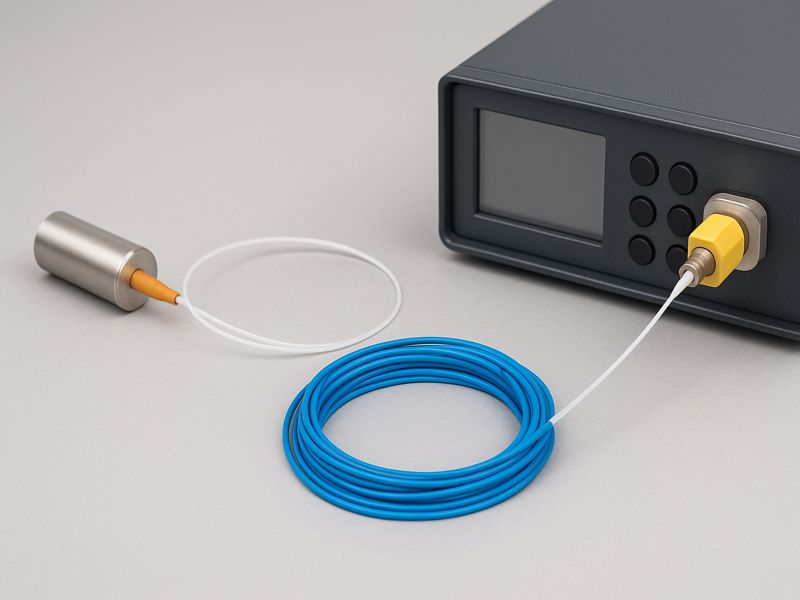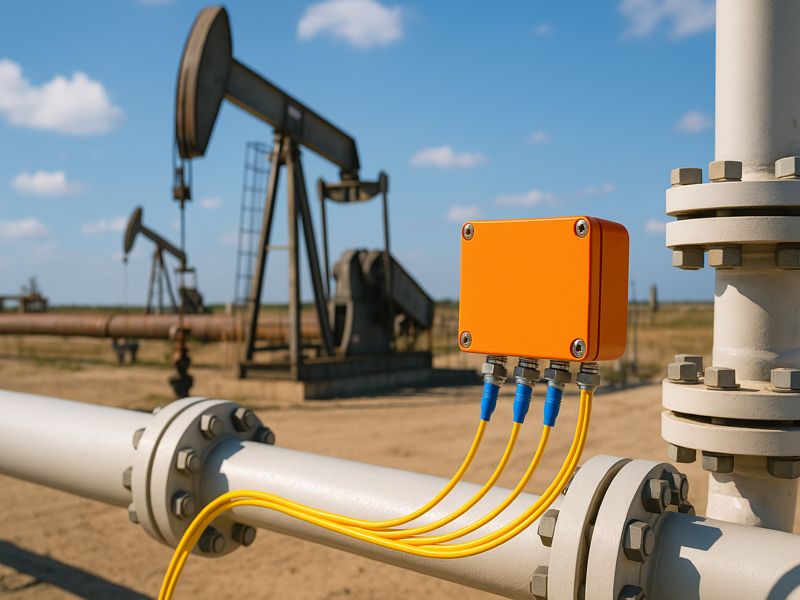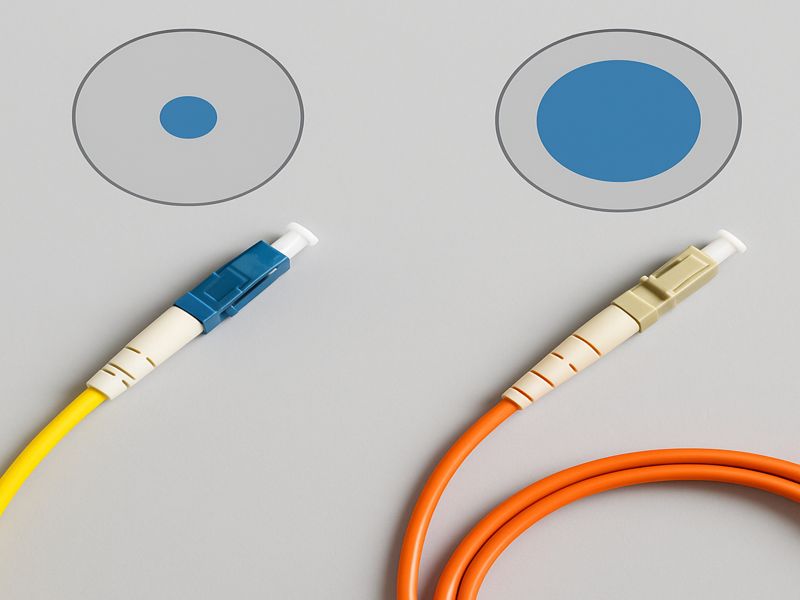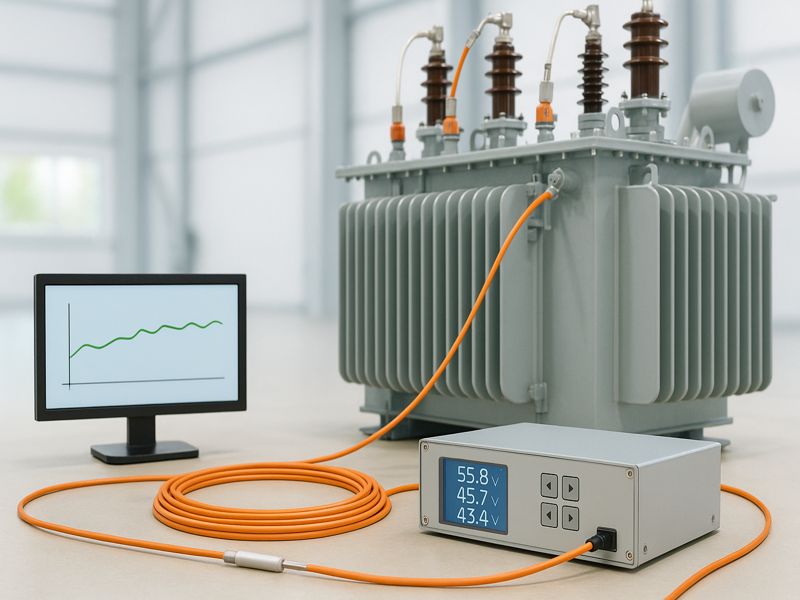Temperature is critical to the safety and performance of systems in power, oil and gas, manufacturing, and transport. As operations grow harsher, traditional sensors like thermocouples and RTDs face limits from interference, range, and safety issues. Fiber optic temperature sensors overcome these challenges by using light instead of electricity, delivering accurate, interference-free, real-time temperature monitoring across long distances. This article examines their working principles, types, benefits, and applications.
The Principle of Fibre Optic Sensing
Fibre optic sensors operate on the principle that light traveling through an optical fiber can be influenced by external physical conditions—such as temperature, strain, or pressure. When temperature changes occur, they cause variations in the properties of the optical fiber (such as refractive index or length), which in turn modify the transmitted light signal.
In essence, fibre optic sensing relies on detecting these light changes—whether in intensity, phase, polarization, or wavelength—and translating them into precise temperature readings. Because optical fibers are made of glass or plastic and transmit light instead of electricity, they are inherently immune to electromagnetic noise and are safe for use in high-voltage or explosive areas.
There are two main sensing modes:
- Point sensing: Measures temperature at specific, discrete locations.
- Distributed sensing: Monitors temperature continuously along the entire length of a fiber—sometimes over tens of kilometers.
Components of a Fibre Optic Temperature Sensor
A typical fibre optic temperature sensing system consists of several key components:
| Component | Function |
| Optical Fiber | Serves as the transmission path for light signals. It can be made from glass (silica) or polymer, depending on the environment. |
| Sensing Element | The section of the fiber or attached device that responds to temperature (e.g., Fibre Bragg Grating, Raman/Brillouin scattering region). |
| Interrogator/Analyzer | Converts the reflected or scattered light into readable temperature data using spectrometry or optical time-domain reflectometry (OTDR). |
| Protective Sheath or Housing | Shields the fiber from mechanical stress, chemical exposure, or high heat, ensuring reliable performance in harsh environments. |
Each component works together to ensure accuracy, stability, and resilience over time, even in environments where electrical sensors would fail.
Working Principle
The working principle of a fibre optic temperature sensor can vary depending on the technology used, but all share a fundamental concept: light changes its properties based on temperature variations.
An Example of Fibre Bragg Grating (FBG)
Periodic changes in the refractive index are imprinted along the fiber core of an FBG sensor. A particular wavelength, known as the Bragg wavelength, is reflected when broadband light travels through the fiber. As temperature changes, the grating spacing and refractive index shift, causing the reflected wavelength to change. By monitoring this wavelength shift, temperature can be precisely calculated.
The relationship can be expressed as:
Δλ = (∂λ/∂T) × ΔT
Where Δλ is the wavelength shift and ΔT is the temperature change.
Other techniques, such as Raman and Brillouin scattering, rely on detecting backscattered light variations, which correspond to temperature gradients along the fiber’s length.
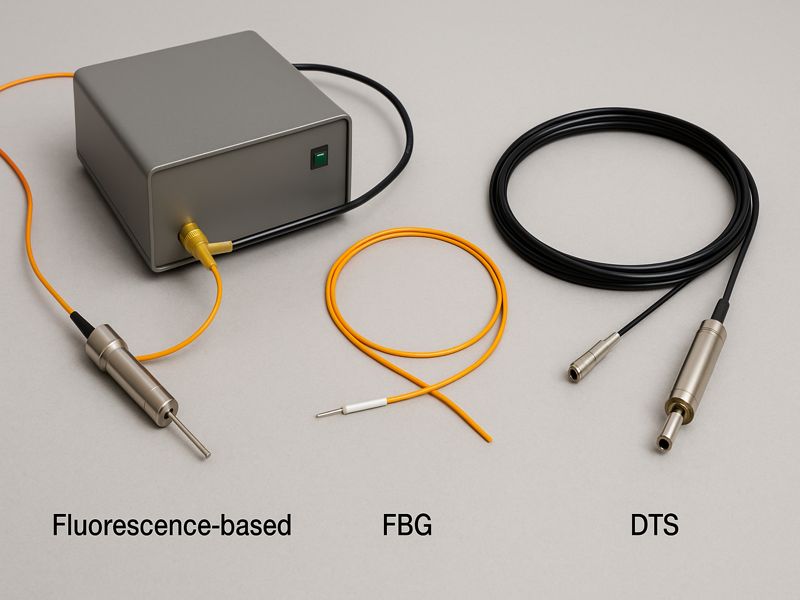
Types of Fibre Optic Temperature Sensors
| Type | Sensing Principle | Key Features | Applications |
| Fibre Bragg Grating (FBG) | Wavelength shift due to temperature and strain changes | High accuracy, multiplexing capability | Power systems, aerospace, medical devices |
| Raman Distributed Temperature Sensor (DTS) | Measures intensity ratio of Stokes and anti-Stokes Raman scattering | Long-distance distributed sensing | Oil pipelines, tunnels, power cables |
| Brillouin Scattering Sensor | Frequency shift proportional to strain and temperature | Measures both temperature and stress | Structural health monitoring, long-distance sensing |
| Interferometric Sensors | Optical phase difference detection | Extremely high sensitivity | Laboratory or precision applications |
Each technology serves distinct needs: FBG sensors are ideal for localized precision monitoring, while Raman and Brillouin systems are perfect for long-distance distributed applications like pipeline or tunnel monitoring.
Key Advantages
Fibre optic temperature sensors provide several advantages over conventional electrical sensing technologies:
Immunity to Electromagnetic Interference (EMI)
Because they transmit light, fibre optic sensors are unaffected by electromagnetic or radio frequency noise—making them ideal near high-voltage lines or substations.
High Accuracy and Stability
They deliver temperature readings with precision down to fractions of a degree Celsius, maintaining accuracy even under vibration or chemical exposure.
Long-Distance Measurement
Distributed systems can monitor temperature profiles along several kilometers of fiber, reducing the need for multiple sensors.
Safety in Hazardous Environments
Since they use no electrical current, they are safe in explosive atmospheres or flammable chemical plants.
Compact and Corrosion-Resistant Design
Optical fibers are thin, lightweight, and resistant to corrosion, making them suitable for integration into confined or harsh spaces.
Multiplexing Capability
A single optical fiber can accommodate dozens or hundreds of sensing points, simplifying cabling and reducing costs.
Common Applications
Because of its versatility and dependability, fiber optic temperature sensors are extensively utilized in many different industries.
Power and Energy
- Real-time monitoring of transformer winding temperatures.
- Cable hot-spot detection in underground and submarine power transmission systems.
- Preventive maintenance in renewable energy systems such as wind turbines.
Oil & Gas
- Monitoring of well temperatures downhole.
- Finding leaks in storage tanks and pipelines.
- Real-time reservoir temperature profiling.
Industrial and Manufacturing
- Process control in refineries, chemical reactors, and furnaces.
- Monitoring high-voltage motors and generators.
- Temperature mapping in composite material curing processes.
Transportation
Tunnel fire detection systems in metro and railway infrastructures.
Aircraft structural monitoring.
Automotive engine testing and battery temperature control.
Data Centers and IT Infrastructure
- Rack-level temperature tracking for efficient cooling management.
- Fiber network thermal integrity monitoring.
Healthcare and Research
- Temperature sensing in MRI environments where electrical sensors cannot operate.
- Biothermal mapping in medical devices or laboratory instruments.
Comparison with Conventional Sensors
| Parameter | Fibre Optic Sensor | Thermocouple/RTD |
| Signal Type | Optical (light-based) | Electrical (voltage/resistance) |
| EMI Resistance | Immune | Susceptible |
| Measurement Range | Up to several kilometers | Localized, short-range |
| Accuracy | High (±0.1°C possible) | Moderate |
| Safety | Intrinsically safe, non-electrical | Risk of spark or short circuit |
| Maintenance | Low | Moderate to high |
| Installation Cost | Higher initial, lower long-term | Lower initial, higher maintenance |
| Multipoint Capability | Excellent (via multiplexing) | Limited |
The comparison clearly shows that fibre optic temperature sensors excel in environments requiring high precision, long-range monitoring, and electrical isolation.
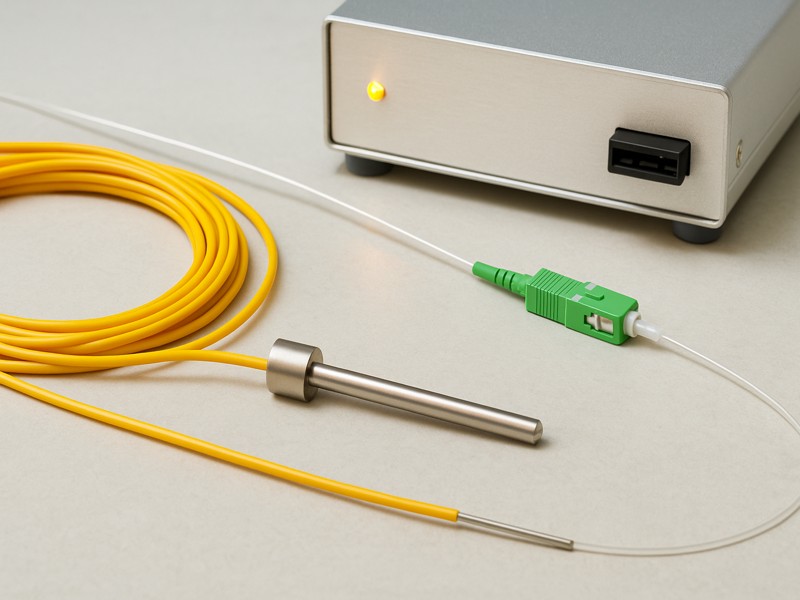
Installation and Maintenance Considerations
Proper installation and maintenance are key to ensuring optimal sensor performance.
Installation Best Practices
- Route fibers carefully to avoid bending below the minimum radius.
- Use protective conduits or armored cables in outdoor or industrial environments.
- Ensure proper splicing or connectorization to minimize optical losses.
- Calibrate sensing systems before deployment to ensure accurate readings.
Maintenance
Fibre optic sensors typically require minimal maintenance. However, periodic inspections for mechanical damage, dirt, or moisture intrusion are recommended. The interrogator system may need occasional recalibration or firmware updates.
Market Outlook and Emerging Trends
The global market for fibre optic sensing technology is rapidly expanding, driven by the growing demand for intelligent infrastructure monitoring, smart grids, and Industry 4.0 automation.
Key trends include:
- Integration with AI and Machine Learning: Enables predictive analytics for early fault detection.
- Miniaturization and Cost Reduction: Advances in fiber fabrication and signal processing are lowering deployment costs.
- Hybrid Sensing Systems: Combining temperature, strain, and pressure monitoring in one fiber for multi-parameter measurement.
- Energy Efficiency and Sustainability: Optical sensors consume less power and contribute to greener monitoring solutions.
Fibre optic temperature sensors represent a transformative advancement in modern measurement technology. They provide unparalleled accuracy, immunity to interference, and long-distance sensing capabilities that conventional sensors cannot match. With expanding use in energy, transportation, and manufacturing sectors, fibre optic sensing is becoming integral to smart monitoring and predictive maintenance strategies.
As industries continue to embrace digital transformation and sustainability, fibre optic temperature sensors will play an essential role in ensuring safety, efficiency, and operational excellence in the connected world.
